Download the eSourcing Handbook
Table of Contents
Introduction to eSourcing
eSourcing is the process of procuring bids from current and potential suppliers via a unified online portal. eSourcing Software streamlines tendering, supplier consolidation, and contract terms to optimize the diverse procurement and sourcing processes in an organization to save time, reduce costs and maximize value from sourcing activities.
Simfoni.com Tweet
Traditionally, a procurement manager’s most crucial or essential skill was the competence to negotiate prices and the terms of a contract with the supplier.
However, the economic disruption from the pandemic has forced many in the procurement sector to adopt technology in order to carry out their business operations more efficiently. One area that has become prominent in procurement is eSourcing due to its cost-saving and operational capabilities.
eSourcing in procurement enables both the sales and procurement departments to expedite and simplify the entire lifecycle of the procurement process. It is a faster and more transparent way of conducting negotiations and facilitating tenders.
However, this is relatively new territory for many procurement departments, so we’ve prepared this comprehensive guide to simplify the process for you. What we have put together here is a one-stop-shop for all things eSourcing. We will walk you through the definitions, the types, the advantages, and the process of introducing eSourcing to your procurement functions.
What is eSourcing?
Electronic sourcing (eSourcing) can be defined as the process of obtaining bids from different suppliers via a single online portal. It is a web-based platform that provides smooth and clear communication between you and your suppliers.
ESourcing enables you to collect and compare information about several suppliers in order to select a preferred supplier.
Additionally, eSourcing involves automating the following core procurement processes:
1. Request for Information (RFI)
In procurement, RFI’s are used to collect and evaluate a broad base of suppliers at a high level. Typically, they focus on suppliers’ capabilities rather than the product, service, or pricing details. An RFI is a valuable tool when looking for new sources of supply.
2. Request for Proposal (RFP)
All suppliers that meet the qualification standards in the RFI can be invited to the RFP. During this process, buyers specify what they are looking to purchase and ask suppliers to provide fulfillment details. Generally, RFPs seek one of two things:
- A Buyer-Defined Solution, i.e., the organization needs a particular product with certain specifications
- A Buyer-Defined Outcome, i.e., the organization needs to solve a business problem, and the supplier needs to recommend a solution.
Typically, RFPs ask for specific responses concerning the company, product, service offering, and pricing. RFPs are valuable tools when you know what you want and need suppliers to supply information on how they will provide what you need.
3. Request for Quotation (RFQ)
Generally, an RFQ is a final step in the sourcing process. Procurement teams negotiate prices and final terms of the agreement. Sometimes, an RFQ can solicit bids on items other than prices, such as service requirements, payment terms, or quantity discounts. An RFQ is a tool to use when you are comfortable with all suppliers bidding but want to get the best deal.
Why Choose eSourcing?
In the procurement sector, eSourcing can serve as a critical tool that assists in improving the procurement process. However, we should emphasize that it is vital first to grasp the concept of eSourcing as a business practice. That is, you must understand how it works, its procedures, benefits, and tools.
eSourcing vs. eProcurement
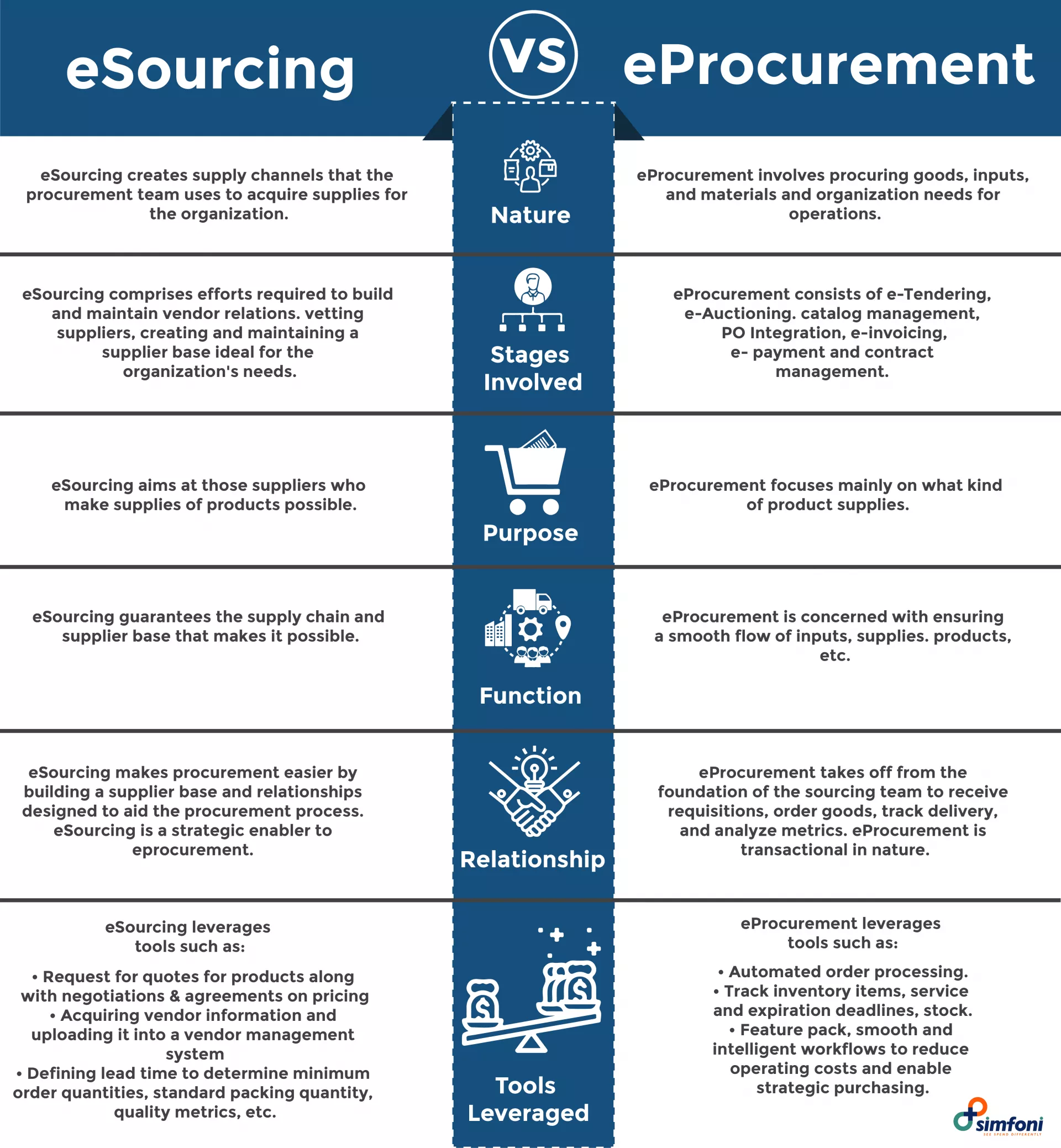
While these two processes might be related, we feel some significant differences are important to highlight.
In terms of eSourcing, the process involves addressing product or service requirements. It also identifies, evaluates, and selects potential suppliers before purchasing. With eSourcing, you can enable bidding, negotiation, and collaboration through a single centralized platform as well as manage documents, quotes, proposals, and contracts for contract lifecycle management.
eProcurement, on the other hand, uses online software to perform the procurement process electronically for the procurement team. It starts with creating purchase requisitions and purchase orders, then placing the order with a reliable vendor based on eSourcing process results.
How is Sourcing Different from eSourcing?
Essential, the processes are the same; in both cases, procurement teams are trying to get the best product from the best suppliers at the best price and terms. However, the critical difference lies in the tools used to execute the strategic and daily sourcing activities.
In today’s digital space, eSourcing is better for procurement than traditional sourcing, which tends to limit efficient collaboration between internal & external stakeholders. Traditional sourcing also limits supplier integration with tools such as email, phones, spreadsheets, PDFs, and even faxes.
Moreover, traditional sourcing tools tend to limit transparency, standardization, scale, and automation. The good news is that all of these elements serve as the foundation for effective eSourcing.
Elements of ESourcing
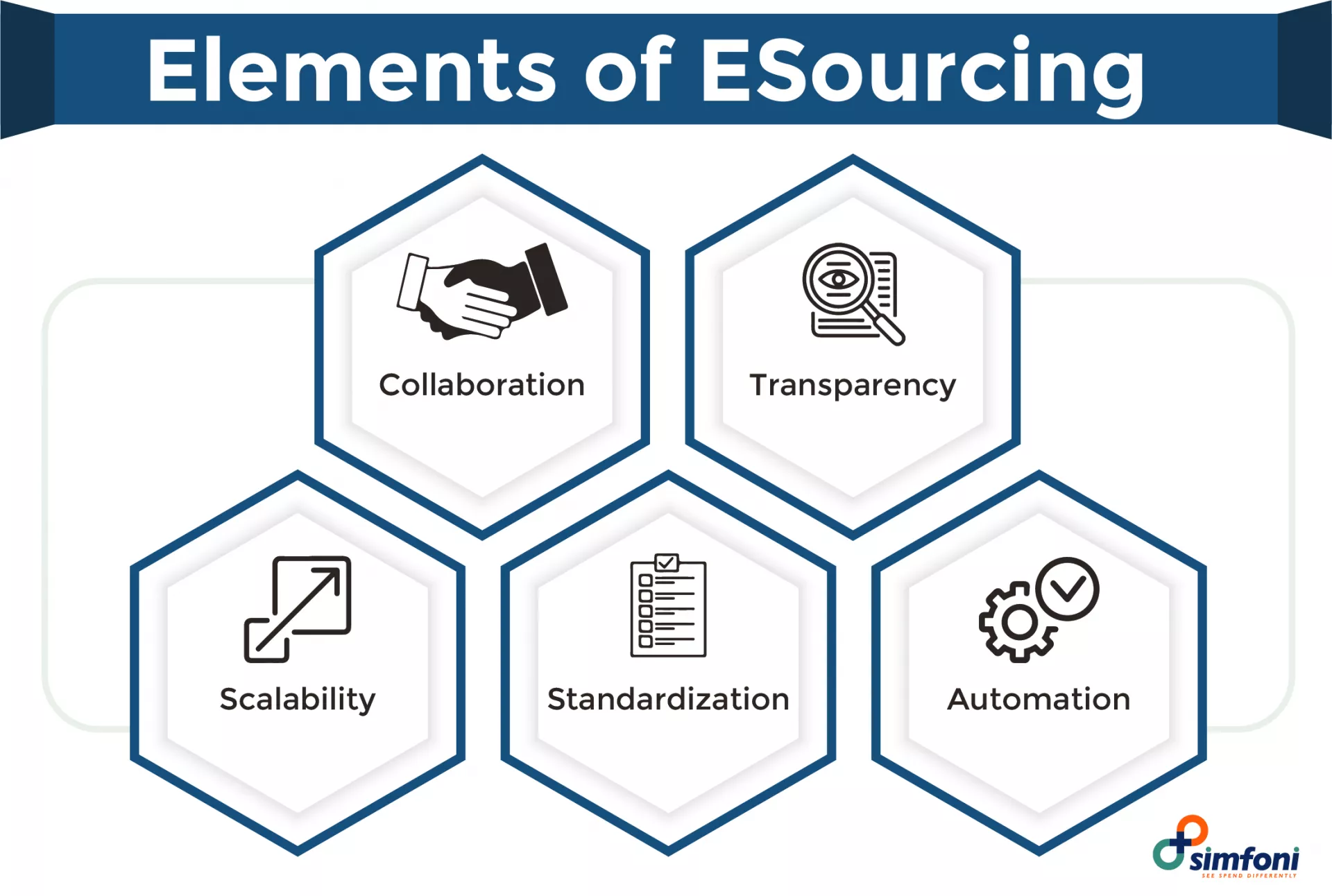
1. Collaboration
Collaborative sourcing involves stakeholders in eSourcing processes such as gathering requirements, reviewing & rating supplier proposals, and selecting the best sourcing option, resulting in an enhanced understanding of products, services, and requirements.
Additionally, improved supplier collaboration increases engagement and generates new and differentiated product and service offerings.
2. Transparency
While traditional sourcing tools limit scheduling, data, analysis, and execution transparency, eSourcing gives teams and stakeholders an opportunity for complete transparency.
And why is this significant? Well, transparency leads to better procurement outcomes due to:
- Improved efficiency
- Collaboration
- Streamlined strategic initiatives
- Improved spend management
3. Scalability
Legacy sourcing systems are manual and include inefficient management, analysis, and coordination activities across the entire organization. Traditional sourcing tools also lack the automation required to manage large volumes of sourcing data, especially if the data is complex and needs significant time and effort to analyze.
On the other hand, ESourcing provides procurement with the ability to manage multiple projects simultaneously and offers transparency when viewing project status and activity. Procurement teams can better manage complex projects.
Additionally, eSourcing enables teams to use e-auctions and other advanced sourcing tools, dramatically speeding up the negotiation time for all procurement processes. Lastly, reporting and analysis can be completed quickly with a push of a button, reducing the workload for your teams.
4. Standardization
Usually, procurement buyers have very little structure or support throughout the sourcing process. This can result in fragmented processes across the organization, leading to operational and supplier confusion, ultimately impacting data quality, decisions, and results.
ESourcing provides procurement teams with standardized, template-based Projects and e-RFx (RFQ, RFP, RFI, Auctions). This simplifies the workflow process and reduces the admin effort in the overall sourcing cycle. For global organizations, standardization makes an even more significant impact on data and analysis quality and coordinating joint initiatives. This is especially useful in the current hybrid-remote workplace and global supply chain market.
5. Automation
Traditional sourcing tools lack automation, requiring significant manual effort from procurement teams to assemble RFx information and processes alert & manage suppliers. With eSourcing, you can enable automated notifications and reminders for buyers, stakeholders, and suppliers.
RFx setup and processes can also be largely automated based on standardized templates, allowing for a seamless transfer of data from repositories, contracts, and requisitions.
Lastly, another automation benefit comes towards the tail end of the RFx process during submission reporting and analysis. ESourcing automated reports can speed up analysis and calculations across vast volumes of line items, products, goods, and services.
How does eSourcing work?
The eSourcing process includes the following steps:
- Defining purchase contract requirements and specifications
- Creating and distributing RFI questionnaires, RFPs, or RFQs to suppliers
- Pre-qualifying suppliers
- Collecting supplier information
- Holding e-auctions, if applicable
- Reviewing competitive bids from qualified suppliers
- Performing analysis and vendor evaluation
- Running e-auctions
- Analyzing and evaluating responses
- Supplier negotiation sessions and reference verification
- Using the portal to c
- Communicate with potential suppliers
- Choosing the winning supplier/s for contract award or purchase
- Awarding contracts
- Drafting supplier contracts
- Delivering contracts or purchase orders to winning suppliers
- Reviewing automated spend analysis by vendor and purchase category
- Maintaining supply chain and supplier relationship management
- Conducting post-contract vendor evaluation
eSourcing Process
Let’s dive a little deeper into the process.
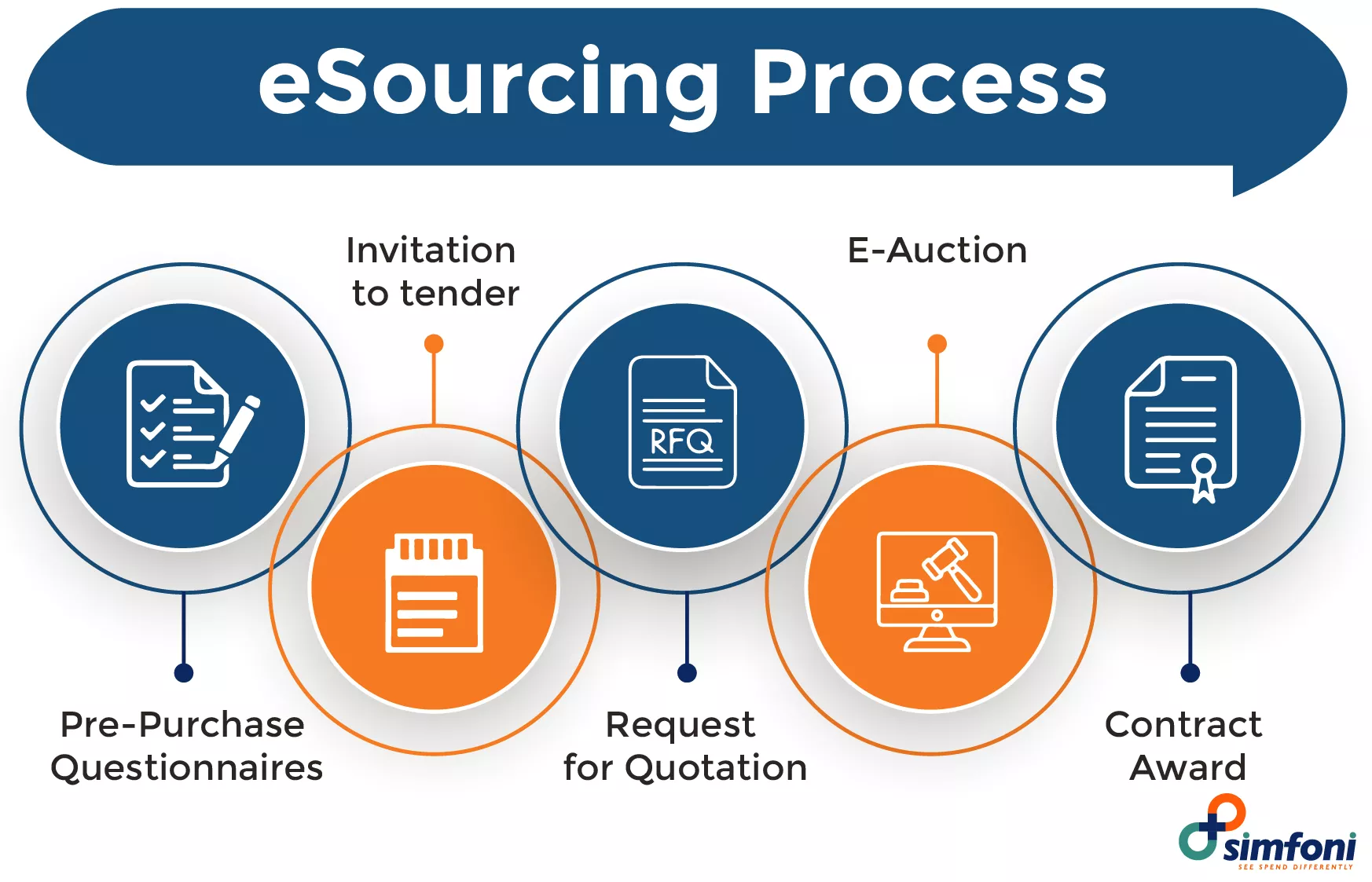
1. Pre-Purchase Questionnaires
The first step usually involves pre-purchase questionnaires that help the buyer identify whether the chosen suppliers are appropriate for doing business. These are detailed documents designed to assess the suitability of a supplier accurately.
2. Invitation to tender
This process involves generating competing offers from different suppliers. Once the supplier list fills out the pre-purchase questionnaire and you have identified which suppliers are going to the next stage of the sourcing process, the system sends them an invitation.
This document gives details on all the organization’s requirements, including information on the required goods or services, necessary supplier details concerning their own policies, practices, and processes, and how the evaluation process will be managed.
3. Request for Quotation
Price is usually the primary consideration when choosing a supplier. So, in this next stage, buyers send out forms for suppliers, asking them to provide prices for the services they can render.
4. E-Auction
At this stage, the suppliers bid on the right to deliver the contract they’ve been invited to tender. The purpose of the auction is to encourage prospective suppliers to compete with one another and, as such, provide the best possible deal for procurement professionals.
A significant advantage of the eSourcing process is that e-Auctions can be run at any point, much like RFIs, PQQs, and RFQs. Once this process is complete, it typically goes to tender, or it may be used after the tender process is complete. It can even run as a standalone event for finished goods in some instances.
5. Contract Award
This is the last stage in the eSourcing process. Many elements can be automated to send the winning bidder a contract automatically.
What is Procurement Auction
We’ve briefly talked about procurement auctions on an eSourcing platform above; however, we need to dedicate more time to it since supplier auctions form a considerable part of the eSourcing process.
So, what is a procurement auction?
This process involves selling or buying goods or services by inviting competing bids from multiple service providers or vendors. Usually, suppliers need to pre-qualify before they can take part in the auction, and this involves:
- Meeting all mandatory supply criteria
- Agreeing to auction and contractual terms and conditions, and
- Agreeing to scope and specifications
In essence, suppliers are competing on price during a procurement auction as everything else would already have been established. While rare, it is possible for suppliers to compete on non-price criteria in an auction, especially in complex procurement auctions, which involve real-time assessing a combination of price, non-price, and associated elements.
The privacy details of the auction differ from company to company, so you’ll find that in some instances, the competing participants may or may not know the identities or actions of other competitors.
Auction Types
Generally, we have two types of procurement auctions: forward auctions and reverse auctions.
In forward auctions, the bids increase during the auction, and in the reverse auction, they decrease. Most procurement departments use online reverse auctions to seek the best value deal.
Let’s look at the auction types in more detail.
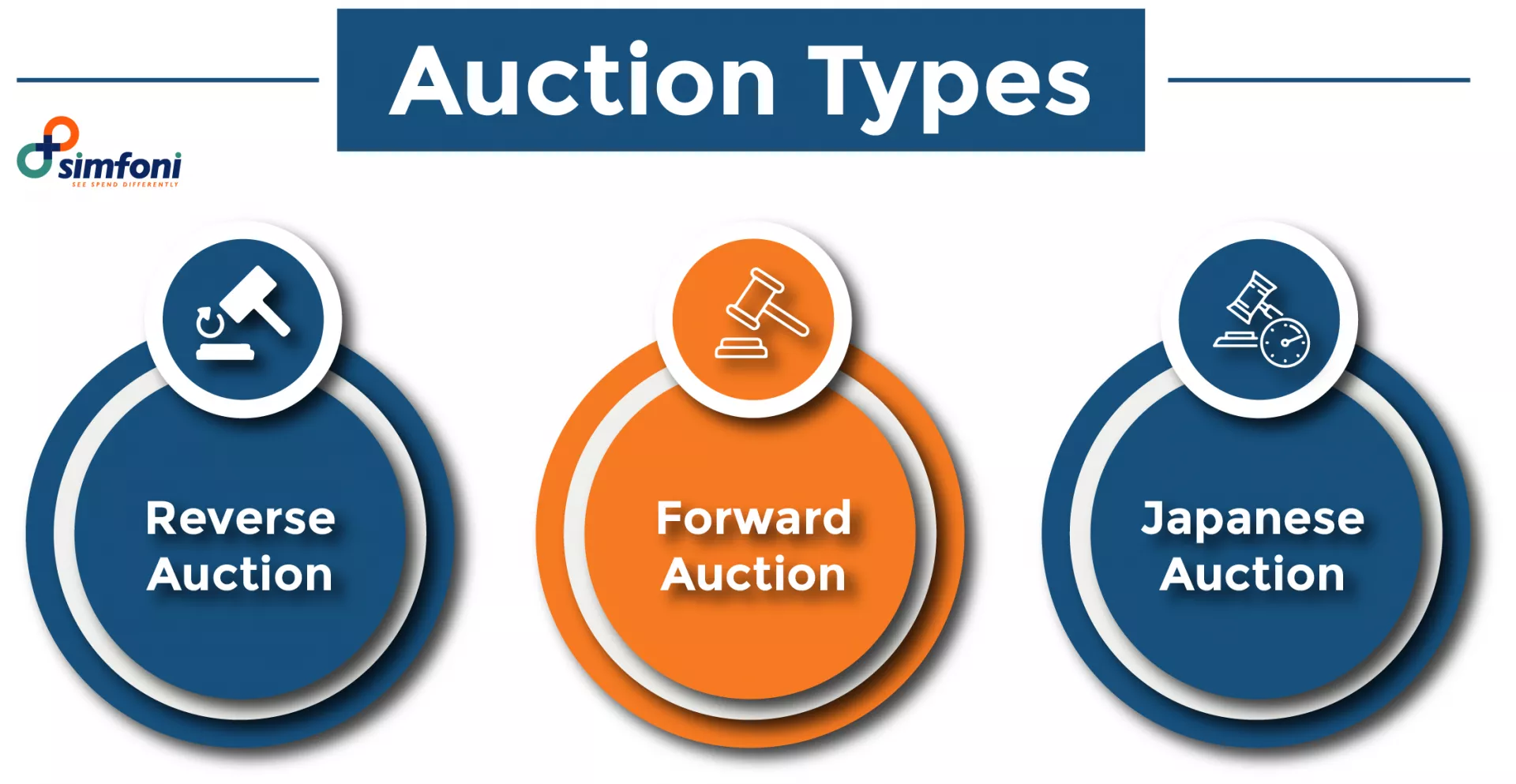
Reverse Auction
In reverse auctions, suppliers are given a starting price to which all participants agree. They then compete against each other by lowering their bids. The supplier with the lowest price wins the auction.
Forward Auction
In this type of auction, suppliers are also given a starting price. Still, it’s usually so low that no supplier would agree to sell their product or service at such a low price. Bidders compete against each other by increasing the price. The forward auction is sometimes also called a dutch auction.
Japanese Auction
Here, prices start so high that all suppliers find it easy to accept. Bidding suppliers then have to signal their acceptance within a specific time frame as pricing goes down rapidly. If a bidding supplier does not signal their acceptance, the buyer removes them from the event.
Once the price is at a level where only one bidding supplier has signaled their acceptance, the auction will close, and the last one standing wins.
How does eSourcing find better Tender Opportunities?
Another great benefit of eSourcing is that the e-auction process helps businesses identify the best tender opportunities.
Once you’ve figured out what you are looking to purchase and host an auction, you can award your contract to any of the suppliers that have placed a bid. You may base your choice on any factor, including the level of service, quality of goods, etc. ESourcing platforms help you find a balance between low price and quality service.
Benefits of ESourcing
Supplier and Purchaser Shared Benefits

There are several benefits that both suppliers and purchasers can leverage by using eSourcing. Some of the shared benefits include:
1. Transparency through technology
Technology has many benefits; among them is the ability to introduce transparency between all involved parties. This is primarily because eSourcing platforms provide real-time responses and feedback via itemized ranking and analytics tools.
So not only do buyers obtain a complete picture of where their vendors and suppliers stand, but vendors also get unprecedented competitive intelligence.
2. It makes the process fair for all suppliers
ESourcing platforms give bidding suppliers equal access to the same information about different buyers. It promotes fair play among all participants so that the best supplier for the job gets an opportunity. It also ensures that participating suppliers have access to the same questions and answers.
ESourcing removes the bias from the procurement process and ensures that procurement teams get the same bid options from different suppliers. In an industry that relies on performance, this is a welcome development.
3. Improves trust between suppliers and build relationships
Traditionally, the manual procurement process goes as follows:
- Procurement teams brief vendors on the details of the service or goods they need
- Suppliers put in their offers
- Procurement then proceeds to negotiate bids from all competing suppliers
- Procurement then presents the pricing offered by supplier A to supplier B
- Suppliers also typically give the pricing offered by buyer A to B
As you can see, this process is tedious and tends to foster an adversarial relationship between buyers and sellers. Moreover, while purchasers may end up with their desired bids at their preferred prices, this process usually leaves many vendors feeling short-changed.
Fortunately, this is a problem that eSourcing can handle. When procurement teams invest in an eSourcing software solution from a specialty vendor like Simfoni, the market shapes the price. Transparency allows all parties to see the necessary information, and suppliers are chosen based on their negotiating skills.
4. It saves time for all involved parties
The procurement process usually involves a lot of delays and consultations before decisions are made. Briefing meetings alone can take hours – if not days – out of an already tedious and busy workload. And this excludes any preliminary negotiations.
By allowing both suppliers and purchasers to access similar templates and collaborate via a centralized eSourcing system, your organization can drastically streamline the entire procurement process.
Additionally, the best eSourcing software provides businesses with streamlined access to important vendor information and supplier data that can be used to make informed purchase decisions while saving time.
5. It opens more business opportunities
Lastly, eSourcing software ensures buyers achieve operational efficiency while extending the ease of use to suppliers as well. Once employees are familiar with how the entire suite works, it’s easier to join bids and open your business to new opportunities.
Overall, eSourcing software creates a level-playing field and opens up new business opportunities to all involved parties.
Additional eSourcing Benefits
ESourcing also brings about the following benefits in procurement:
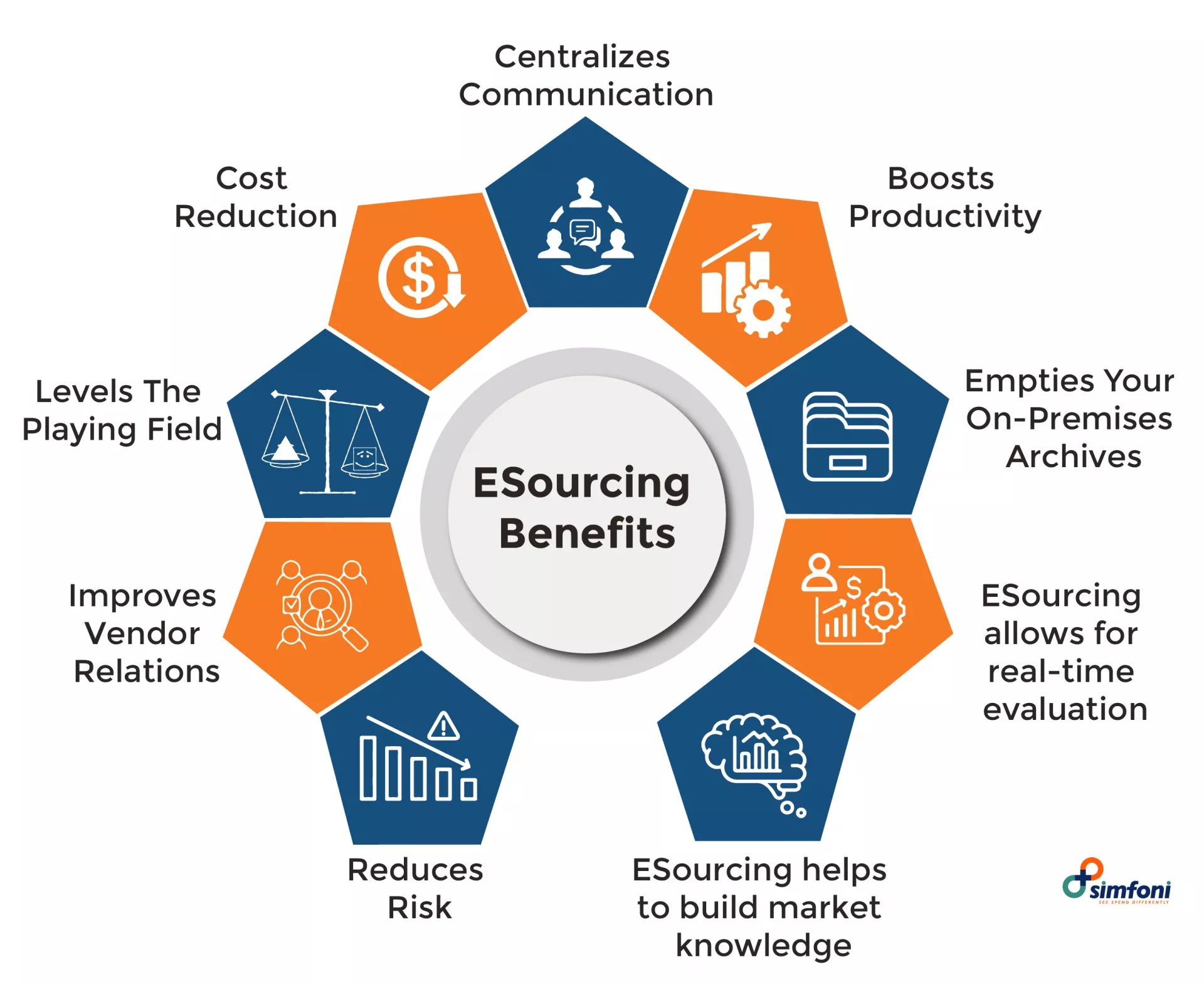
1. Reduces Risk
Every business process carries some form of risk, even procurement. However, with the standardized approach of eSourcing, companies can control their call for bids and audit trail to remain compliant.
2. Improves Vendor Relations
We’ve already touched on this, but we feel we need to reiterate. With increased transparency and openness between purchasers and suppliers, eSourcing can significantly improve vendor relations leading to better efficiency and cooperation.
3. Levels The Playing Field
For start-ups and smaller companies who have more modest sales and procurement departments, it can provide a platform to demonstrate the value of goods or services.
4. Cost Reduction
In today’s business environment, saving money has become extremely important. ESourcing is an excellent way of achieving it. Procurement teams can access and review several suppliers’ bids allowing them to shortlist suppliers efficiently.
5. Centralizes Communication
ESourcing enables effective communication and evaluation of suppliers. This means suppliers can receive detailed requirements in a single eSourcing platform and seamlessly communicate throughout the bidding process.
Moreover, all information can also be easily accessed if necessary, reducing or eliminating long email chains and lengthy conference calls.
6. Boosts Productivity
A productive workforce equals more revenue. With e-sources, employees can use their time to focus on complex tasks rather than routine, repetitive tasks—productivity and employee satisfaction soar.
7. Empties Your On-Premises Archives
When you conduct everything on a digital platform, you empty unnecessary on-premise storage archives. You can repurpose that space for something more productive than storage, whether it’s an office or a building.
8. ESourcing allows for real-time evaluation
In today’s global market, real-time data evaluation is crucial because sudden shifts in economies or lockdown announcements, for example, can impact your procurement processes significantly.
So, depending on the eSourcing tool you use, there is a wide variety of analyses done by the tools themselves. Most eSourcing software like Simfoni’s includes multiple types of embedded reports, which allow you to respond quicker with initial feedback, identify outliers, and find the best bids per product, service line, business unit, and so on.
Of course, you cannot wholly discard post-hoc analysis. Still, the good news is that your procurement team will spend much less time collating, cleansing, and comparing bids in an eSourcing tool than in a manual process.
9. ESourcing helps to build market knowledge
By using eSourcing, your organization can have a consistent approach to the market by collecting and storing critical information that can be re-used in the next sourcing cycle.
If you are starting your sourcing process, it can help you move more efficiently through the supplier selection process.
What are the challenges of eSourcing?
As a relatively new process, there are some challenges that come with implementing eSourcing in your procurement functions. Let’s take a look at what they are below.
1. The declining value of cost-savings
For a long time, cost reduction has been the primary reason for procurement teams adopting eSourcing. However, basing investment decisions on affordability – especially after significant savings have already been achieved, can lead to a decline in the quality of service for suppliers.
This can leave many businesses feeling unsatisfied with their suppliers despite achieving excellent pricing.
Nevertheless, the ability of eSourcing to deliver cost efficiencies for procurement teams remains very relevant, regardless of how significant the gains made in the past. Procurement teams must communicate to suppliers and upper management the importance of other factors in supplier selection.
This process might require a significant shift from a business’s tendency to focus on year-over-year savings and instead consider the annuity value of past savings achievements.
2. Lack of support for ESourcing 's other benefits
Lack of support for other eSourcing benefits results from the declining value of cost-savings outlined above. To maximize the benefits of eSourcing, procurement teams and management must understand that there is so much more to strategic sourcing than achieving the lowest bids for a project.
Ideally, eSourcing is designed to reduce costs while delivering high-quality and relevant proposals for a particular project. This means there must be a good balance between cost and quality.
The battle for procurement teams is that upper management is usually unable to recognize the role that quality plays in the whole procurement process. Most business leaders are too focused on the bottom line and the overall cost-saving benefits.
Ultimately, this can prove detrimental to the success of any project.
3. Insufficient understanding of objectives
An eSourcing platform makes it easy to host bidding events and send out requests for proposals (RFPs). However, attracting the attention of quality suppliers to ensure quality bids requires creating an effective RFP.
Therefore, procurement teams need to understand why they need a particular service. This goes back to your objectives. Suppose the team behind the whole initiative is not provided with a clear understanding of what they’re looking for. In that case, it will ultimately lead to poor results.
4. Lack of insight into effective decision-making
This last factor is related to the previous point. Most teams underestimate the importance of evaluating proposals correctly to attract suitable suppliers. If procurement teams don’t fully understand their objectives, they won’t create reliable evaluation criteria.
The result of this is a business that bases its decisions on something that might not be wholly relevant or sustainable for a long-term working relationship.
Suppose you can identify these challenges from the beginning. In that case, you can take a closer look at your procurement process and reassess how you can maximize your eSourcing platform to deliver the best results.
What is eSourcing Software?
ESourcing software is a platform that equips procurement teams with the necessary digital tools to centralize and optimize the entire sourcing process, such as supplier onboarding, qualification, data management and analysis, sourcing events management, contract management, and accessible communication between the sourcing team and suppliers.
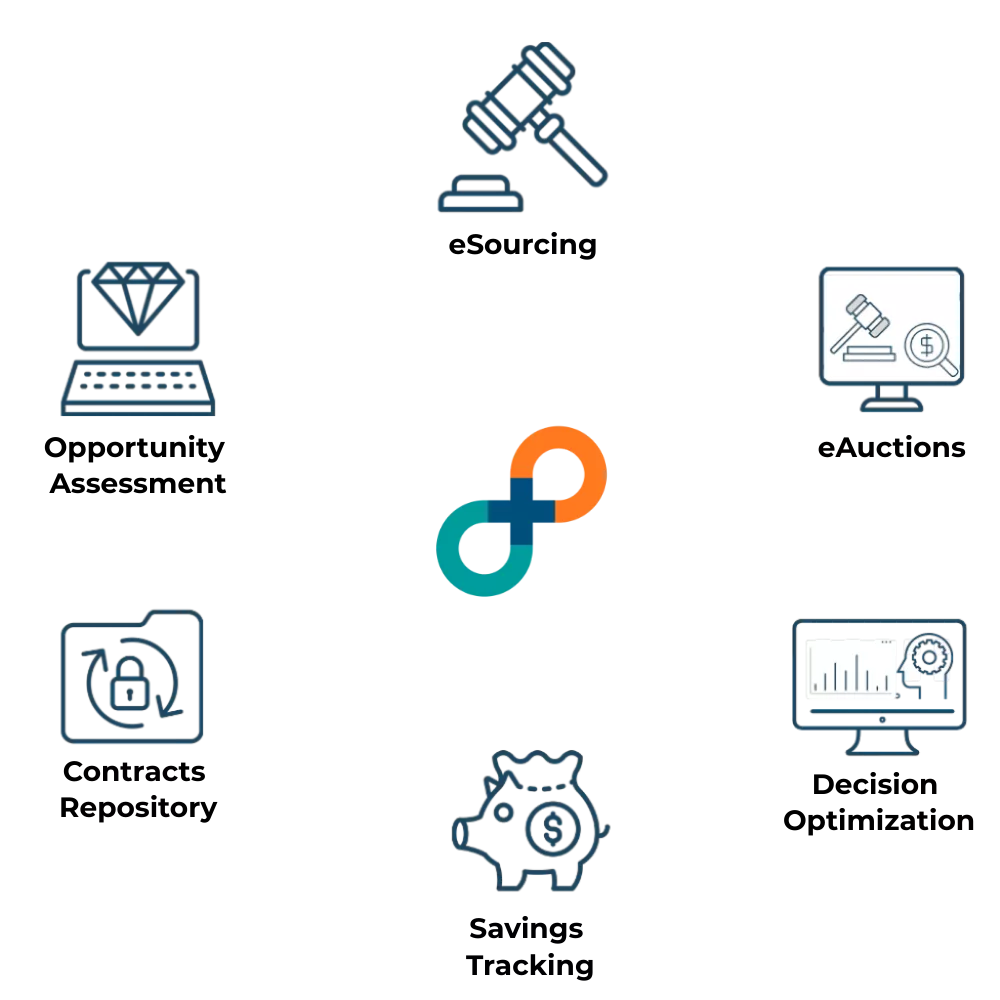
Modern sourcing software integrates all stages of the source-to-contract process, such as:
- Supplier pre-qualification and onboarding
- RFx and e-auction management
- Contract management
- Supplier performance analysis
- Savings tracking.
ESourcing software solutions like Simfoni’s provide a smooth end-to-end supply chain, integration with ERP, procurement software, a BI solution, and so on. On average, the implementation of custom sourcing software can take around ten months, depending on the solution complexity.
For large enterprises, the ROI of sourcing software can reach 900%+.
However, not all eSourcing software is created equal, and there are a few essential features that you should be on the lookout for.
ESourcing Software Features
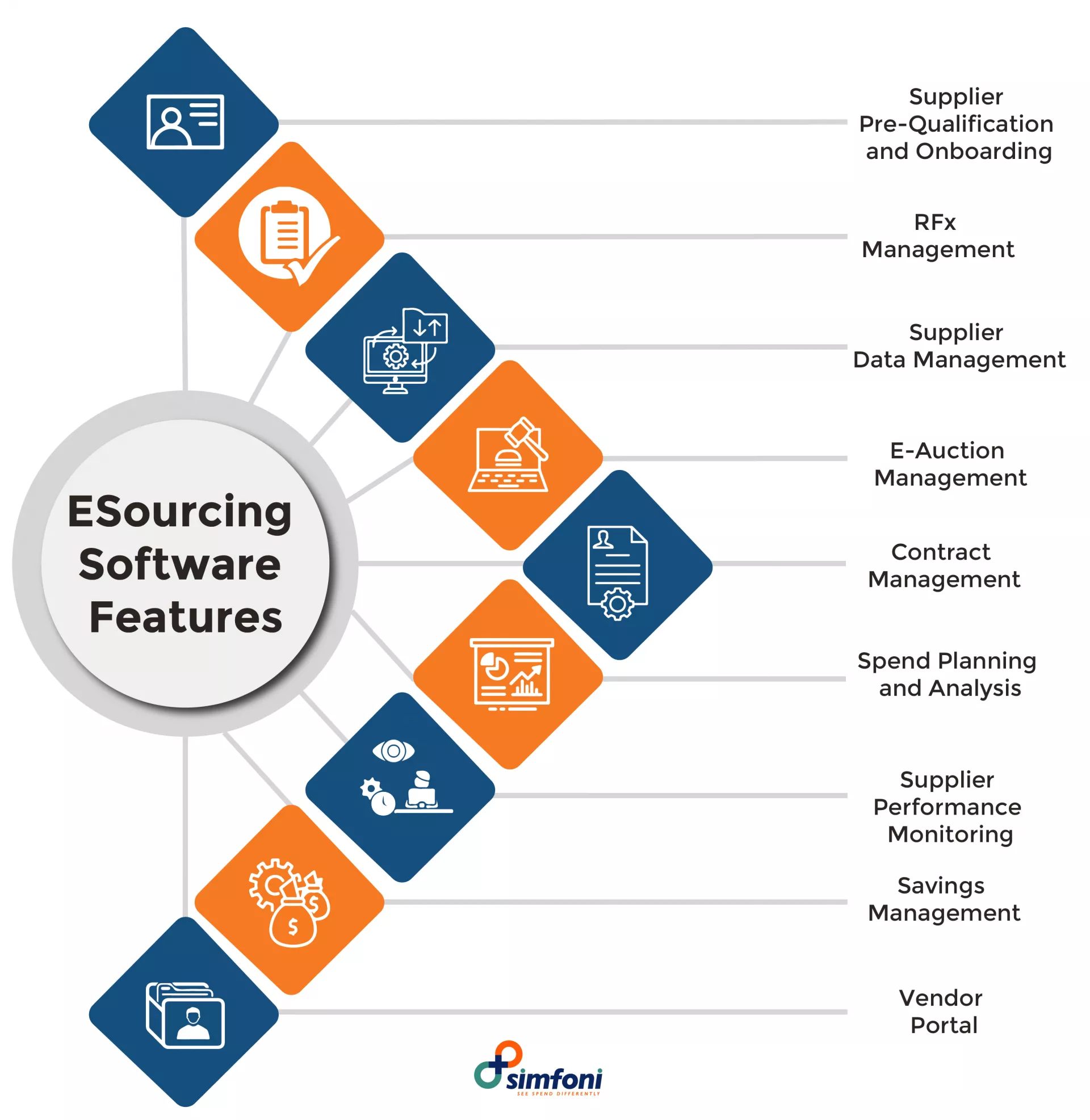
Great eSourcing software should help you source better by providing the following basics:
- Drag-and-drop functionality for RFX creation
- Using mapping & export support to make decisions based on non-price factors
- The potential scalability in a single sourcing event
- Price flexibility to flip your pricing tables from Ms Excel into the module while drafting RFXs
- Interactive what-if evaluation and automated supplier ranking
- An in-built platform to identify critical suppliers for negotiation and to register the savings achieved after every round of negotiation
- Quick Source’ to create RFXs on a single page for instant and straightforward sourcing activities
- Automated approval workflow for all events based on various business policies of an organization
- Ability to flip the pricing & non-pricing information along with attachments from the sourcing event into a contract
Additionally, your software of choice should include specific procurement tools such as:
1. Supplier pre-qualification and onboarding
Your eSourcing software should be able to:
- Setup supplier requirements based on factors such as quality standards, sustainability, capacity, delivery terms as well as on the internal sourcing policies
- Have AI-enabled supplier pre-qualification based on pre-set requirements that have been set using data from public data sources such as a credit rating platform
- Customizable registration forms for supplier and sub-supplier onboarding
- Automated supplier categorization according to user-defined parameters such as product or service category, region, strategic priority, and so on
- Customizable supplier approval workflow.
2. RFx Management
The eSourcing platforms should be able to produce:
- Template-based Request for Information (RFI), Request for Proposal (RFP), Request for Quote (RFQ) forms
- RFx co-authoring
- Customizable multi-department RFx approval workflows
- Real-time RFx status tracking for both sourcing specialists and suppliers
- Scheduled/ad-hoc RFx submission to selected suppliers
- Automated RFx evaluation based on user-defined selection criteria such as quality, cost, capacity for supplier scoring, and selection.
3. Supplier Data Management
Real-time supplier data management is essential in this volatile global supply chain market. So your software must:
- Centralize storage of all supplier-related data, including general information about supplier companies, current capacity, supplier interaction history, ongoing activities, and pricing.
- Centralize supplier document storage such as contracts, accreditations, supplier compliance certifications, and business requirements.
- Have search engine with filtering and metadata querying to navigate supplier-related data and documents
4. E-Auction Management
The auction process is an essential part of the procurement process, so your software should be able to:
- Create a rule-based e-auction system
- Configurable auction page templates
- Support the various e-auction types, including forward auction, reverse auction, a Japanese auction, a Dutch auction, and so on
- Create template-based supplier invitations e-auction participation
- Run multiple e-auctions across various lots in parallel
- Create an interactive display providing a real-time centralized view into supplier bids
- Provide a rule-based e-auction extension for last-minute bid activity
- Provide you with AI-enabled cost-benefit analysis and bid compliance scoring for supplier bids comparison
- Give customizable supplier award rules to comply with various sourcing policies, e.g., multi-sourcing of mission-critical items
5. Contract Management
Error in contract management can have dire consequences on your bottom line. So automated contract management is a must-have. Look for a software solution with the following contract management features:
- Template-based creation of supplier contracts
- Collaborative contract review and editing that gives access to internal stakeholders and suppliers
- Configurable contract approval workflows that collect approvals of internal stakeholders and suppliers
- Real-time contract status tracking (approved, signed, etc.)
- Scheduled alerts to a sourcing team on a supplier contract start, expiry, renewal dates
- Automated contract version control.
6. Spend Planning and Analysis
Organizations that can proactively manage their spend through automation and technology can have a significant competitive advantage. So, your software should have the following features:
- Spend planning that is defined according to period, category, supplier, department, business entity, and so on. Planning should also be based on historical spend data analysis as well as internal and customer demand data
- Real-time spend calculation and tracking
- Rule-based categorizations of product and service categories that require spend optimization.
Our Spend Management Solutions at Simfoni distills and organizes your complex spend data. With our AI-powered solution, all spend is rapidly & accurately reviewed and classified. You gain real-time visibility across all categories, as well as insights that pinpoint hidden savings. Quickly examine spending trends, price variances, commonality & tail-spend.
We’ve fused revolutionary technology with AI-enabled content and deep expertise to automate, streamline and simplify procurement. The result: a composable, on-demand spend management platform that takes the hassle out of procurement.
7. Supplier Performance Monitoring
Real-time supplier data is crucial, so be on the lookout for software that can:
- Configure dashboards with a real-time supplier activity overview
- Monitor supplier performance against pre-defined KPIs, such as percentage of purchase orders delivered on time, the average delay in purchase order execution, the number of backorders, and so on
- Perform AI-powered analysis of reputational, financial, operational, and other supplier risks based on internal and public data sources
- Rate and rank suppliers based on performance and the level of engagement
8. Savings Management
Organizations need to focus on cost savings and investing in a procurement savings tracker is non-negotiable. Your software should have savings management features that provide real-time overviews of actual realized savings. Additionally, it should:
- Set user-defined savings targets using sourcing events, product/service category, supplier, and so on
- Automate savings calculation based on RFx and e-auction data
- Conduct savings tracking against pre-set savings targets
- Create customizable templates for savings reports
- Include a savings forecasting future according to period, category, SKU, location, and so on.
9. Vendor Portal
A vendor portal is essential, and it has double benefits for both sourcing teams and suppliers, so your software should include the following:
Sourcing team features:
- Instant messaging for faster communication with suppliers and sub-suppliers
- Template-based and custom supplier surveys
- Individual or bulk sending of supplier surveys for valuable supplier feedback on collaboration
Supplier features:
- Supplier self-registration which includes managing and updating essential company information
- Supplier profiles that include details on all related supplier activities such as available RFxs and e-auctions, contract reviews, and so on
- Real-time alerts to suppliers on received RFxs, invitations for e-auction participation, expiring data that need updating, etc.
- Supplier forum that includes interactive Q&A sections and a knowledge base that has R&D results, demand forecasts, and so on.
Conclusion – ESourcing Solutions by Simfoni
At Simfoni, we understand the role technology plays in digitally transforming procurement processes for businesses. Simfoni eSourcing removes the inefficient, labor-intensive processes of traditional sourcing and replaces them with a unique combination of powerful, AI-backed technology and experienced sourcing professionals.
With our solution, you can rest assured that problematic guesswork, manual spreadsheet analysis, time-consuming drilling through numerous spend and operations categories, or countless contract comparisons will be a thing of the past. Simfoni makes it easy to improve spend management at the source.
As a cloud-based platform, Simfoni delivers a future-proofed, right-sizing spend management solution that puts you in control of your spend from the start. Simfoni lets you mix, match, and create your perfect platform using a wide array of sourcing and spend management modules and tools with our composable architecture.
You can run RFx events and combine them with any of Simfoni’s seamlessly integrated e-auction, auto-scoring, dynamic bidding, or decision support tools, all to manage, enhance and meet your organization’s unique sourcing and business goals. What’s more, Simfoni gets you up & running fast and will scale to meet your exact needs.
Simply put, our software can:
- Track, analyze, and get more out of your spend before it’s on the books with eSourcing. Identify and consolidate preferred suppliers, prevent spend fragmentation at every level, improve contract terms, and much more.
- Manage, compare and analyze any request type—Sealed Bids, RFI, RFQ, RFP, RFx, and more—inside Simfoni, and connect to virtually any sourcing data source, from ERP and CRM to VMS and flat files.
- Can provide automated and fully configurable bidder scoring and feedback lets you save time and energy from collecting and analyzing data and helps you make the right decisions at the start of your buying process.
- Manage and visualize limitless variables, calculations, and dimensions of sourcing events to find value quickly through AI-backed scenario navigation and sourcing initiative assessments.
Take advantage of our consultative approach to sourcing and procurement and deploy custom-tailored templates and reporting to meet your organization’s exact spend management needs quickly.
Frequently Asked Question (FAQ)
For your help, we have created a list of answers to assist you more.
What is eSourcing?
eSourcing, short for electronic sourcing, is a digital procurement process that leverages technology and online platforms to streamline and optimize the procurement of goods and services. It encompasses various activities, including supplier identification, negotiation, bidding, and contract management, all conducted electronically.
What is an example of eSourcing?
An example of eSourcing is an organization using an online platform to invite suppliers to submit electronic bids for a specific project or procurement need. Suppliers can access the platform, view procurement requirements, submit their offers digitally, and participate in real-time negotiations, all without the need for physical documents or in-person meetings.
What is eSourcing in e-procurement?
In the context of e-procurement, eSourcing is a critical component that focuses on the electronic management of the sourcing process. It involves using digital tools and platforms to efficiently identify suppliers, request quotes or proposals, evaluate supplier responses, and negotiate terms—all with the aim of optimizing procurement outcomes.
What is the difference between e-purchasing and eSourcing?
e-Purchasing and eSourcing are related but distinct concepts in e-procurement:
- e-Purchasing refers to the electronic buying of goods or services, often involving online catalogs, purchase orders, and electronic payments.
- eSourcing, on the other hand, specifically focuses on the electronic sourcing and procurement process, which includes activities such as supplier identification, negotiation, and bidding.
While e-purchasing handles the transactional aspects of procurement, eSourcing deals with the strategic sourcing and supplier relationship management phases.
How does eSourcing work?
eSourcing typically works through the following steps:
- Supplier Identification: Organizations identify potential suppliers for a particular procurement need.
- Request for Information (RFI): Organizations use eSourcing platforms to request information from suppliers regarding their capabilities, products, or services.
- Request for Proposal (RFP) or Request for Quotation (RFQ): Detailed procurement requirements are electronically communicated to suppliers. Suppliers respond with proposals or quotes.
- Bid Evaluation: Organizations evaluate supplier responses using predefined criteria, often facilitated by eSourcing software.
- Negotiation: Real time online negotiations may occur allowing organizations to fine tune terms and conditions.
- Contract Management: Once an agreement is reached contracts can be created, signed, and managed electronically.
- Supplier Relationship Management: Post-procurement, organizations use eSourcing tools to manage ongoing supplier relationships and performance.
What are the benefits of eSourcing?
The benefits of eSourcing include:
- Efficiency: Streamlined processes reduce time and effort in procurement activities.
- Cost Savings: Competitive bidding and negotiation can result in cost reductions.
- Transparency: All procurement-related data is accessible and transparent.
- Supplier Collaboration: Improved communication and collaboration with suppliers.
- Data Analytics: Data-driven decision-making through analysis of supplier performance and pricing trends.
- Compliance: Enhanced adherence to procurement policies and regulations.
What is the use of eSourcing?
Primary use of eSourcing is to enhance the efficiency and effectiveness of procurement processes. It enables organizations to:
- Identify and engage with potential suppliers.
- Collect and evaluate supplier proposals and quotes.
- Conduct real-time negotiations to optimize terms and pricing.
- Facilitate contract creation and management.
- Monitor supplier performance and compliance.
- Achieve cost savings and transparency in procurement activities.
What are eSourcing tools?
eSourcing tools are software solutions designed to facilitate and automate various aspects of the sourcing and procurement process. These tools typically include:
- Supplier Database: Stores information about potential suppliers.
- RFI/RFP/RFQ Templates: Standardizes the request process.
- Bid Evaluation: Assists in evaluating supplier responses.
- Negotiation Platforms: Supports real-time online negotiations.
- Contract Management: Helps create, store, and manage contracts.
- Analytics: Provides data-driven insights for decision-making.
- Supplier Performance Monitoring: Tracks supplier performance and compliance.
These tools help organizations streamline eSourcing activities and improve procurement outcomes.
How can eSourcing contribute to sustainability in procurement?
eSourcing can contribute to sustainability in procurement by:
- Supplier Evaluation: It enables organizations to assess and select suppliers with strong sustainability practices.
- Transparency: eSourcing platforms provide visibility into supplier environmental and social responsibility efforts.
- Cost Reduction: By optimizing supplier selection and negotiation, eSourcing can identify sustainable options that are cost-effective.
- Data Analytics: It allows organizations to track and measure the environmental impact of their supply chain.
What industries benefit the most from eSourcing?
While eSourcing can benefit various industries it is particularly advantageous for industries with complex supply chains, high procurement volumes and a need for competitive pricing. Industries such as manufacturing, healthcare, retail and construction often benefit significantly from eSourcing due to its efficiency and cost-saving potential.
Are there any security concerns related to eSourcing?
Yes, security concerns can arise in eSourcing, primarily related to the handling of sensitive procurement data and supplier information. To mitigate these concerns, organizations should:
- Implement robust data security measures.
- Ensure data encryption and secure access controls.
- Conduct regular security audits and assessments.
- Choose reputable eSourcing platforms with strong security protocols.
How can small and medium-sized enterprises (SMEs) leverage eSourcing?
SMEs can leverage eSourcing to:
- Gain access to a wider pool of potential suppliers.
- Compete on a level playing field with larger organizations.
- Streamline procurement processes and reduce administrative costs.
- Negotiate favorable terms and pricing with suppliers.
- Enhance transparency and data-driven decision-making in procurement.
What role does eSourcing play in strategic procurement?
eSourcing plays a pivotal role in strategic procurement by enabling organizations to:
- Identify and engage with strategic suppliers.
- Conduct competitive bidding and negotiation to optimize terms.
- Align procurement decisions with broader business objectives.
- Enhance supplier relationship management and collaboration.
- Facilitate data-driven strategic decision-making in procurement.
How has the adoption of eSourcing evolved over the years?
The adoption of eSourcing has evolved significantly over the years, with organizations increasingly recognizing its benefits. Initially, it focused on basic online procurement activities. Today, it encompasses a wide range of advanced tools and platforms for supplier management, negotiation, and contract management, driven by the need for efficiency, cost savings, and data-driven insights.
What are the best practices for successful eSourcing implementation?
Successful eSourcing implementation involves:
- Clear Objectives: Define specific goals and objectives for eSourcing initiatives.
- Stakeholder Engagement: Involve key stakeholders, including procurement teams and suppliers.
- Robust Training: Provide comprehensive training for users of eSourcing tools.
- Data Management: Ensure accurate and clean data for effective eSourcing.
- Continuous Improvement: Embrace a culture of ongoing improvement in eSourcing practices.
- Compliance: Ensure that eSourcing activities align with legal and regulatory requirements.
By following these best practices, organizations can maximize the benefits of eSourcing.